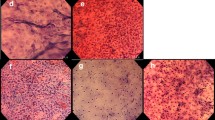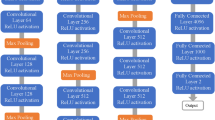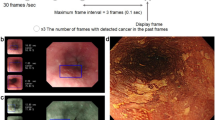Abstract
Objectives
In Japan, endoscopic resection (ER) is often used to treat esophageal squamous cell carcinoma (ESCC) when invasion depths are diagnosed as EP-SM1, whereas ESCC cases deeper than SM2 are treated by surgical operation or chemoradiotherapy. Therefore, it is crucial to determine the invasion depth of ESCC via preoperative endoscopic examination. Recently, rapid progress in the utilization of artificial intelligence (AI) with deep learning in medical fields has been achieved. In this study, we demonstrate the diagnostic ability of AI to measure ESCC invasion depth.
Methods
We retrospectively collected 1751 training images of ESCC at the Cancer Institute Hospital, Japan. We developed an AI-diagnostic system of convolutional neural networks using deep learning techniques with these images. Subsequently, 291 test images were prepared and reviewed by the AI-diagnostic system and 13 board-certified endoscopists to evaluate the diagnostic accuracy.
Results
The AI-diagnostic system detected 95.5% (279/291) of the ESCC in test images in 10 s, analyzed the 279 images and correctly estimated the invasion depth of ESCC with a sensitivity of 84.1% and accuracy of 80.9% in 6 s. The accuracy score of this system exceeded those of 12 out of 13 board-certified endoscopists, and its area under the curve (AUC) was greater than the AUCs of all endoscopists.
Conclusions
The AI-diagnostic system demonstrated a higher diagnostic accuracy for ESCC invasion depth than those of endoscopists and, therefore, can be potentially used in ESCC diagnostics.


Similar content being viewed by others
References
Kamangar F, Dores GM, Anderson WF. Patterns of cancer incidence, mortality, and prevalence across five continents: defining priorities to reduce cancer disparities in different geographic regions of the world. J Clin Oncol. 2006;24:2137–50.
Wei WQ, Chen ZF, He YT, et al. Long-term follow-up of a community assignment, one-time endoscopic screening study of esophageal cancer in China. J Clin Oncol. 2015;33:1951–7.
Natsugoe S, Baba M, Yoshinaka H, et al. Mucosal squamous cell carcinoma of the esophagus: a clinicopathologic study of 30 cases. Oncology. 1998;55:235–41.
Tajima Y, Nakanishi Y, Tachimori Y, et al. Significance of involvement by squamous cell carcinoma of the ducts of esophageal submucosal glands. Analysis of 201 surgically resected superficial squamous cell carcinomas. Cancer. 2000;89:248–54.
Bollschweiler E, Baldus SE, Schröder W, et al. High rate of lymph-node metastasis in submucosal esophageal squamous-cell carcinomas and adenocarcinomas. Endoscopy. 2006;38:149–56.
Higuchi K, Koizumi W, Tanabe S, et al. Current management of esophageal squamous-cell carcinoma in Japan and other countries. Gastrointest Cancer Res. 2009;3:153–61.
Kuwano H, Nishimura Y, Oyama T, et al. Guidelines for diagnosis and treatment of carcinoma of the esophagus April 2012 edited by the Japan Esophageal Society. Esophagus. 2015;12:1–30.
Horie Y, Yoshio T, Aoyama K, et al. Diagnostic outcomes of esophageal cancer by artificial intelligence using convolutional neural networks. Gastrointest Endosc. 2019;89:25–322.
Kanda Y. Investigation of the freely available easy-to-use software ‘EZR’ for medical statistics. Bone Marrow Transpl. 2013;48:452–8.
Makuuchi H, Shimada H, Mizutani K, et al. Endoscopic criteria for invasive depth of superficial esophageal cancer. Dig Endosc. 1997;9:110–5.
Chino O, Makuuchi H, Shimada H, et al. Diagnosis of the invasion depth of superficial esophageal carcinoma. Gastroenterol Endosc. 2015;57:1243–53 (in Japanese with English abstract).
Ebi M, Shimura T, Yamada T, et al. Multicenter, prospective trial of white-light imaging alone versus white-light imaging followed by magnifying endoscopy with narrow-band imaging for the real-time imaging and diagnosis of invasion depth in superficial esophageal squamous cell carcinoma. Gastrointest Endosc. 2015;81:1355–61.
Thosani N, Singh H, Kapadia A, et al. Diagnostic accuracy of EUS in differentiating mucosal versus submucosal invasion of superficial esophageal cancers: a systematic review and meta-analysis. Gastrointest Endosc. 2012;75:24253.
Shimizu Y, Kato M, Yamamoto J, et al. EMR combined with chemoradiotherapy: a novel treatment for superficial esophageal squamous-cell carcinoma. Gastrointest Endosc. 2004;59:199–204.
Saeki H, Watanabe M, Mine S, et al. Esophagectomy for superficial esophageal cancer after non-curative endoscopic resection. J Gastroenterol. 2015;50:406–13.
Nakagawa K, Ishihara R, Aoyama K, et al. Classification for invasion depth of esophageal squamous cell carcinoma using a deep neural network compared with experienced endoscopists. Gastrointest Endosc 2019 (Epub ahead of print).
Funding
This study was funded by the Uehara Memorial Foundation.
Author information
Authors and Affiliations
Corresponding author
Ethics declarations
Ethical statement
This article does not contain any studies with human participants performed by any of the authors.
Conflict of interest
Tomohiro Tada is a shareholder of AI Medical Service Inc.
Additional information
Publisher's Note
Springer Nature remains neutral with regard to jurisdictional claims in published maps and institutional affiliations.
Rights and permissions
About this article
Cite this article
Tokai, Y., Yoshio, T., Aoyama, K. et al. Application of artificial intelligence using convolutional neural networks in determining the invasion depth of esophageal squamous cell carcinoma. Esophagus 17, 250–256 (2020). https://doi.org/10.1007/s10388-020-00716-x
Received:
Accepted:
Published:
Issue Date:
DOI: https://doi.org/10.1007/s10388-020-00716-x




